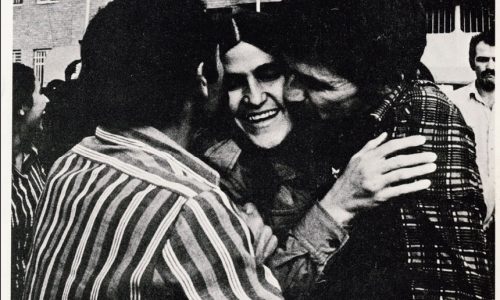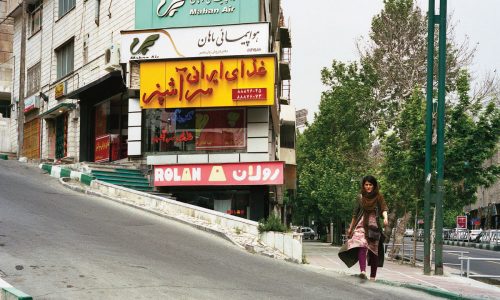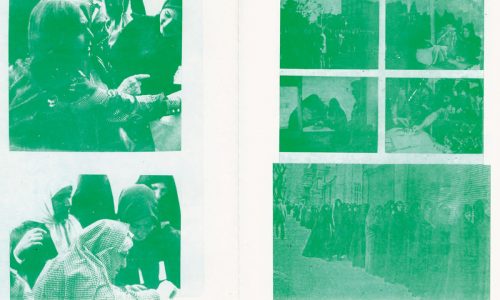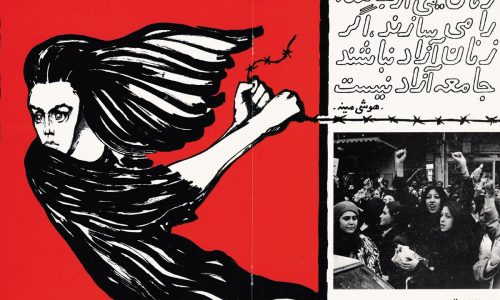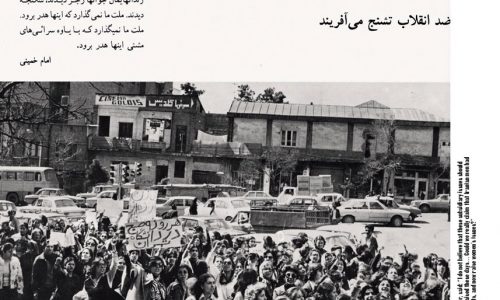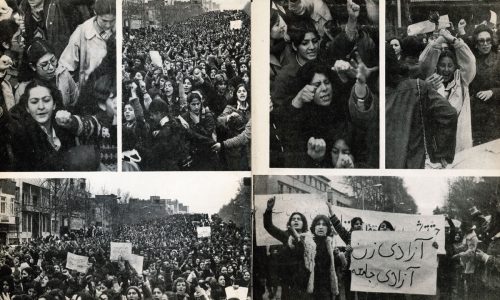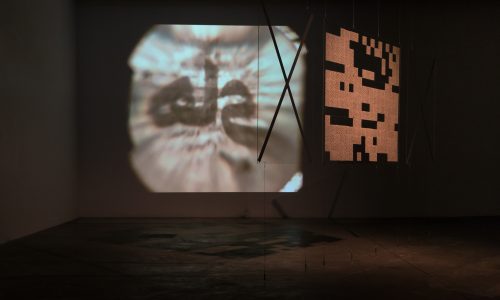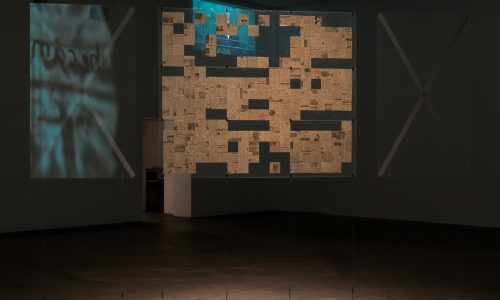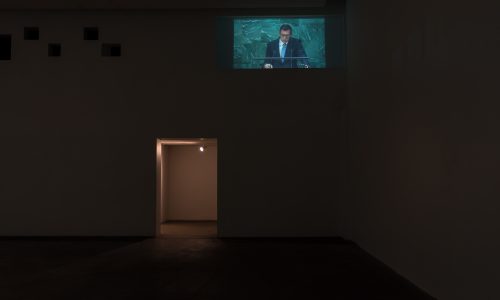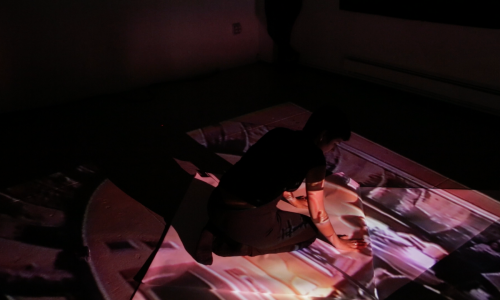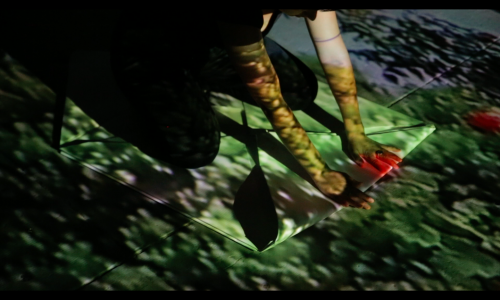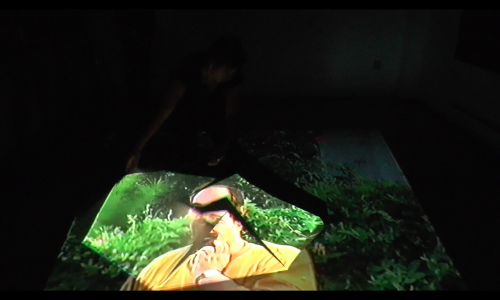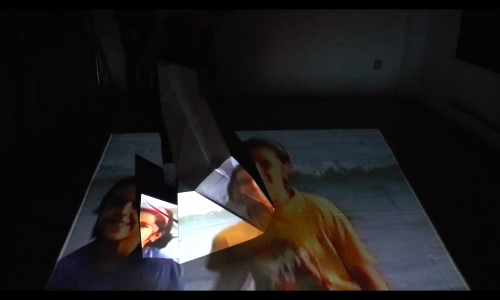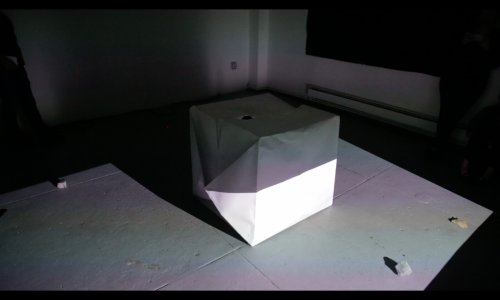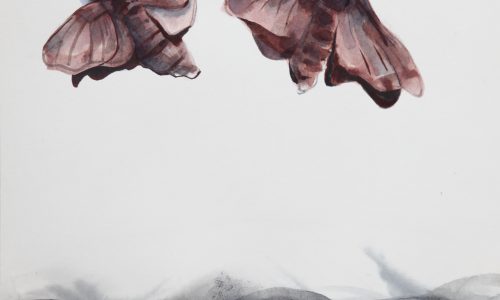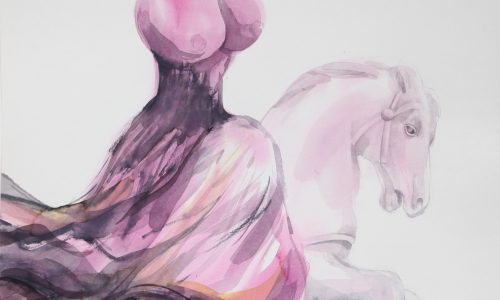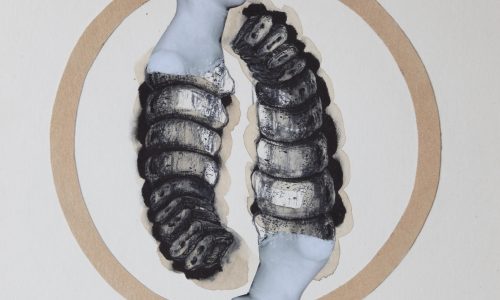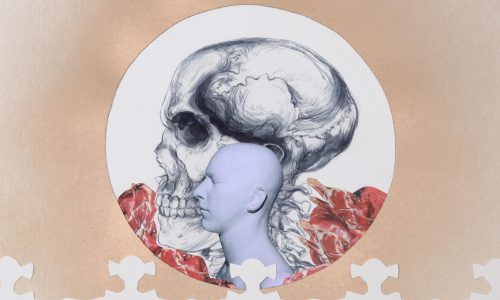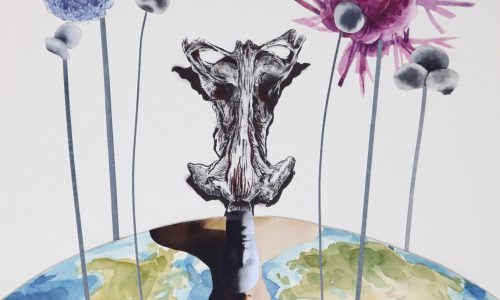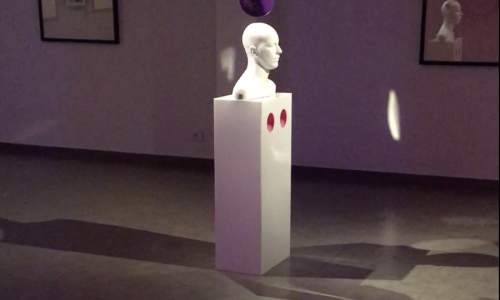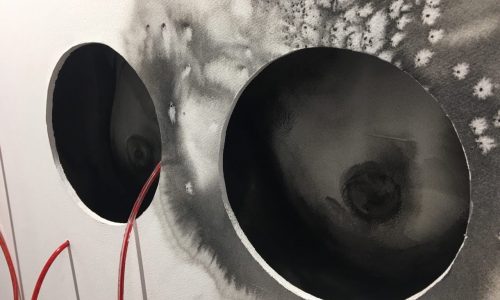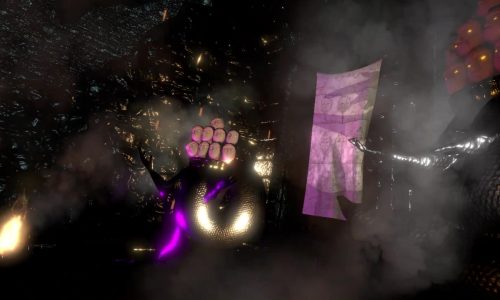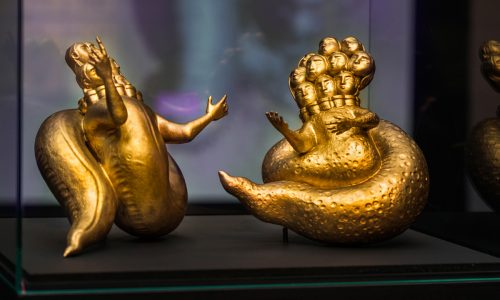The five artists showcased here all grew up in the 1980s, the first decade following the 1979 Revolution and the decade of the Iran-Iraq War. Their varying artistic approaches make their works distinct from the victimizing images of Middle Eastern women highly romanticized by the orientalist gaze. While Hannah Darabi and Gelare Khoshgozaran use public archives to understand women’s participation during the revolution and their lives during the Iran-Iraq War respectively, Nooshin Rostami uses a personal archive of family records and her own body to reflect on her experiences of immigration and exile. Niloufar Keyhani’s work also draws from a very personal experience yet deals with the political conditions of a later period, particularly the U.S.-led sanctions imposed in the last decade against Iran. Similarly, Morehshin Allahyari’s work is informed by recent U.S. policy–the Muslim ban–however, she uses a combination of VR technology and mythology to tell her story.
Hannah Darabi
Enghelab Street: Iran 1979-1983: A Revolution through Books
Published by Spector Books and Le BAL, 2019
Hannah Darabi’s book, Enghelab Street, a Revolution through Books; Iran 1979-1983 is a collection based primarily on multiple accounts of the 1979 revolution. It consists of photo books published during and immediately following the Iranian revolution. In addition, it includes the so-called “white covers,” books that had been published illegally under the pre-revolutionary regime of the Shah. Following the revolution in 1979, these books were released by small independent publishing houses during a short time where the boundaries of government censorship were unclear. They included political books, prisoners’ memoirs, translation of theoretical (generally Marxist) reference works, party literature, and manuals of state propaganda among others. Iran effectively had no government censorship during this brief period in 1979 between the downfall of the Shah’s regime and the consolidation of the Islamic Republic.
In the final section, titled Reconstructions, Darabi has gathered pages from various photo books and placed them alongside contemporary images of Tehran (the city in which she grew up), including family photos and images representing the pop culture of the time. The selection here is part of the third Reconstruction and begins with images showing the role of women in the Iranian revolution of 1979, and later on, protesting the new law for mandatory hijab on 8th March 1979. These photos retell stories that were forgotten or erased from the official narratives of the Iranian revolution, demonstrating the absence of any collective image of this momentous movement.
Artist’s bio: Iranian artist born in 1981 in Tehran, Hannah Darabi studied photography at the Faculty of Fine Arts in Tehran, and then at the University Paris VIII. Today based in Paris, her country of origin remains the main subject of most of her photographic series. In order to reveal the complex political situation of this country, she creates series in which her photographs interact with other materials, such as texts, archival images or objects. The artist’s book occupies a privileged place among other forms of representation that she explores. Her books are part of public and private collections, and her recent work, Enghelab Street, a Revolution through Books, Iran 1979-1983, has received numerous awards.
Gelare Khoshgozaran
Cosmos, Two-channel Video Installation, 2016
Gelare Khoshgozaran‘s Cosmos also uses an archive, one of crossword puzzles from (1985-1986) in Kayhan (Cosmos), an Iranian hardline newspaper. These were the months during which the artist’s mother was pregnant with her during the Iran-Iraq War. This war, lasting from 1980-1988, was the longest conventional war of the 20th century with estimates of about 1,000,000 casualties on both sides. It included five series of air raids and in the second series (March 22 to April 8, 1985) a number of major cities in western Iran were attacked. The piece also includes images of three instances the U.N. General Assembly unanimously voted for the end of the Iran-Iraq War in 1982, 1986, and 1988.
The video projection of the newspaper resembles an image of an ultrasound with certain words hovering above it as Khoshgozaran reimagines her mother being pregnant with her. The contrast between an intimate experience and the banality of crossword puzzles reflect the complexity of life under circumstances of war.
Artist’s bio: Gelare Khoshgozaran is an undisciplinary artist and writer who, in 2009 was transplanted from street protests in a city of four seasons to the windowless rooms of the University of Southern California where aesthetics and politics were discussed in endless summers. Using time-based media and film, her practice encompasses literary theory, translation, and autobiographical fiction. Her essays and interviews on art, politics and culture have been published in contemporary (co-founder), The Brooklyn Rail, Parkett, X-TRA, The Enemy, Art Practical, Flat Journal, Ajam Media Collective and Temporary Art Review, amongst others. Her work has been presented in solo and group exhibitions at the New Museum, Queens Museum, Eyebeam, Hammer Museum, LAXART, Human Resources, Articule (Montreal), Beursschouwburg (Brussels) and Pori Art Museum (Pori, Finland). She was the recipient of a Creative Capital | Andy Warhol Foundation Arts Writers Grant (2015) and an Art Matters Award (2017).
Nooshin Rostami
Paperwork, Performance, 2015
Nooshin Rostami uses a more personal archive, that of family home videos from her childhood. In Paperwork, the artist folds a large piece of paper while the videos are projected onto the paper. The performance ends when the artist enters a cube made out of the folded paper. Paperwork resembles one’s struggle for building a new home or a new self while carrying the weight of past memories with one’s own body. It is “the performative embodiment of the artist’s journey as an immigrant, exploring the inseparable politics of family, profession, immigration, and exile” as Rostami puts it.
Artist’s bio: Nooshin Rostami (b.Shahroud, Iran) is a New York-based interdisciplinary artist. Her practice traverses varied media including drawing, sculpture, installation and performance. Rostami’s work is deeply influenced by her story of exile and memory of displacement. Often usingthe language of light and abstraction, she creates experiences that examine the impact of displacement as physical, emotional and psychological conditions.
Through a metaphorical construction and often game-like processes, Rostami creates “Reflective structures” and spatial landscapes that constitute personal, social and political narratives. These structures are at times architectural constructs or reflected objects and at times site-specific places of thinking and reflection. Her research is focused on human perception of space, place and landscape acting as a means to probe the fundamental aspects of the human condition.
Rostami has exhibited, performed and presented her work in solo and group settings in Austria, Canada, Germany, India, Iran, Italy, Mexico, Spain, and the United States, including Queens Museum, BRIC Contemporary Art and California Museum of Photography-UCR.
Niloufar Keyhani
Point-to-Point,Multimedia, 2016-2019
Personal experience is also central in Niloufar Keyhani’s works, both as a child growing up during the Iran-Iraq War and as an adult who has survived cancer. Her Point-to-Point series portrays a visceral experience while embodying the existential questions of life and death as well as pain and healing.
In her installation Bloody Red, a red tube representing Doxil, a chemotherapy drug, is injected through one of the two large holes carved out of a white box that represent her body as the drawing of a bent head over the box suggests. For Keyhani, as many others, the trauma of the cancer was overshadowed by the shortage of medicine caused by the U.S.-led economic sanctions imposed on Iran in 2011.
Artist’s bio: Niloufar Keyhani holds a Bachelor of Arts in Painting from Azad University of Tehran (2006). She has been in more than forty group exhibitions in Iran, Italy, Lebanon, USA, Croatia, and Austria as well as two solo exhibitions in Tehran and Beirut. She was an Artist-in-Residency at Scuola Internazionale di Grafica di Venezia, Italy in 2013. In 2018, she was awarded the Boston Cultural Council Opportunity Fund Grant and Chashama Organization and United Breast Cancer Foundation Opportunity Fund Grant.
Morehshin Allahyari
She Who Sees The Unknown-Ya’jooj Ma’jooj, Multimedia, 2018
Morehshin Allahyari uses mythology to reflect on personal experience affected by socio-political circumstances. The story of Ya’jooj Ma’jooj resonated with the artist while she found herself on the other side of “the wall” during the U.S. Muslim travel ban in 2017. Ya’jooj Ma’jooj is part of a larger series She Who Sees The Unknown, in which Allahyari reimagines female/queer figures of Islamic and Middle Eastern origin using the traditions and myths associated with them. While, in the Quran, Allah had a wall built to contain Ya’jooj Ma’jooj, monstrous figures who represent chaos, Allahyari’s version of the story embraces their “monstrosities” as they resemble ‘the other.’ Here, Ya’jooj Ma’jooj break through the wall in an act of resistance. Although they are pushed back, they “emerge again in an eternal recurring battle of ‘us versus them,’” as Allahyari puts it.
Artist’s bio: Morehshin Allahyari is a media artist and activist who uses computer modeling, 3D scanning, and digital fabrication techniques to explore the intersection of art and activism. Inspired by concepts of collective archiving and cultural contradiction, Allahyari’s 3D-printed sculptures and videos challenge social and gender norms. She wants her work to respond to, resist, and criticize the current political and cultural situation that is experienced on a daily basis. Her work has been part of numerous exhibitions, festivals, and workshops at venues throughout the world, including the New Museum, MoMa, Centre Pompidou, Venice Biennale di Archittectura, and Museum für Angewandte Kunst among many others.
She is the recipient of The Joan Mitchell Foundation Painters & Sculptors Grant (2019), The Sundance Institute New Frontier International Fellowship, and the leading global thinkers of 2016 award by Foreign Policy magazine. Her 3D Additivist Manifesto video is in the collection of San Francisco Museum of Modern Art, and recently she has been awarded major commissions by The Shed, Rhizome, New Museum, Whitney Museum of American Art, Liverpool Biennale, and FACT.
Curator’s Bio: Azadeh Tajpour is a multidisciplinary artist based in Boston. She is a recipient of numerous awards and artist residencies, including the Massachusetts Cultural Council Artists Fellowship, The Studios at Mass MoCA, Virginia Center for the Arts, Boston Center for the Arts, Art Omi, and more. She has exhibited in Boston, Los Angeles, Mexico, Canada, the United Kingdom, and Iran. Her documentary Film, Gazing through a Lens—ʿAli Khan Documents 19th-Century Iran, has been screened at the Harvard Art Museums, Aga Khan Documentation Center at MIT, and Boston College. She is the senior editorial assistant at Women’s Worlds in Qajar Iran Digital Archive at Harvard University.
